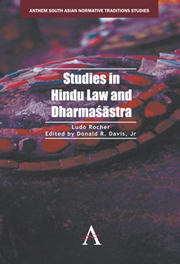Book contents
- Frontmatter
- Contents
- Foreword by Richard W. Lariviere
- Preface
- Abbreviations
- Note on the Edition
- Introduction
- PART ONE THE NATURE OF HINDU LAW
- PART TWO GENERAL TOPICS OF HINDU LAW
- Ancient Hindu Criminal Law
- Hindu Law of Succession: From the Śāstras to Modern Law
- Caste and Occupation in Classical India: The Normative Texts
- Megasthenes on Indian Lawbooks
- The “Ambassador” in Ancient India
- The Status of Minors according to Classical Hindu Law
- Quandoque bonus dormitat Jīmūtavūhanas?
- Notes on Mixed Castes in Classical India
- Inheritance and Srāddha: The Principle of “Spiritual Benefit”
- The Theory of Matrimonial Causes According to the Dharmaśāstra
- Jīmūtavūhana's Dāyabhāga and the Maxim Factum Valet
- The Divinity of Royal Power in Ancient India according to Dharmaśāstra
- A Few Considerations on Monocracy in Ancient India
- PART THREE HINDU LEGAL PROCEDURE
- PART FOUR TECHNICAL STUDIES OF HINDU LAW
- PART FIVE ANGLO-HINDU AND CUSTOMARY LAW
- Bibliography
- Index
The Theory of Matrimonial Causes According to the Dharmaśāstra
from PART TWO - GENERAL TOPICS OF HINDU LAW
Published online by Cambridge University Press: 05 February 2013
- Frontmatter
- Contents
- Foreword by Richard W. Lariviere
- Preface
- Abbreviations
- Note on the Edition
- Introduction
- PART ONE THE NATURE OF HINDU LAW
- PART TWO GENERAL TOPICS OF HINDU LAW
- Ancient Hindu Criminal Law
- Hindu Law of Succession: From the Śāstras to Modern Law
- Caste and Occupation in Classical India: The Normative Texts
- Megasthenes on Indian Lawbooks
- The “Ambassador” in Ancient India
- The Status of Minors according to Classical Hindu Law
- Quandoque bonus dormitat Jīmūtavūhanas?
- Notes on Mixed Castes in Classical India
- Inheritance and Srāddha: The Principle of “Spiritual Benefit”
- The Theory of Matrimonial Causes According to the Dharmaśāstra
- Jīmūtavūhana's Dāyabhāga and the Maxim Factum Valet
- The Divinity of Royal Power in Ancient India according to Dharmaśāstra
- A Few Considerations on Monocracy in Ancient India
- PART THREE HINDU LEGAL PROCEDURE
- PART FOUR TECHNICAL STUDIES OF HINDU LAW
- PART FIVE ANGLO-HINDU AND CUSTOMARY LAW
- Bibliography
- Index
Summary
Introduction
Before dealing with the subject of matrimonial causes according to the Dharmaśāstra a few comments on the title of this paper may not be out of place. These comments will be mainly of a methodological nature.
A first comment is that the Dharmaśāstra does not have a Matrimonial Causes Act, as is the case in England since 1857. In other words, in the whole of ancient Hindu law one would look in vain for a treatise, or even for a separate chapter, dealing exhaustively with what we call matrimonial causes. The result is that the data which I shall present to you as a more or less coherent whole are really drawn from various unrelated chapters of Dharmaśāstra literature.
This first comment leads me on to my second preliminary remark. The fact that no Sanskrit text deals with matrimonial causes as such should not make you think that the data upon which I shall have to work are few in number. In reality they are numerous, far too numerous to be dealt with at all completely in a short paper. Moreover, they are not only numerous; as is the case with most other topics of ancient Hindu law, here, too, the various sources often seem to contradict or even to be repugnant to each other.
- Type
- Chapter
- Information
- Studies in Hindu Law and Dharmasastra , pp. 279 - 304Publisher: Anthem PressPrint publication year: 2012

